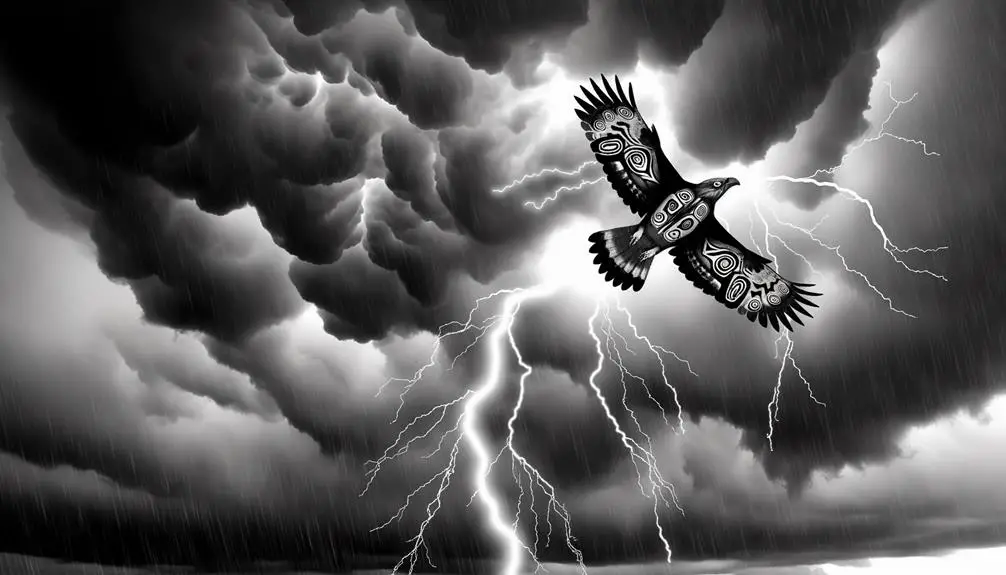What Is the Native American Symbol for Strength?
In Native American cultures, symbols such as the bear, eagle, and thunderbird represent strength. The bear epitomizes power, resilience, and protective nature, while the eagle signifies higher perspective, insight, and guardianship.
The thunderbird symbolizes immense spiritual power and supremacy over nature's elements. Additionally, the buffalo represents sustenance and survival.
These symbols are deeply embedded in Native American traditions, rituals, and artistic expressions, collectively highlighting enduring values and communal strength. Each symbol not only embodies physical might but also spiritual and emotional fortitude.
Continue to uncover the intricate meanings behind these powerful symbols in cultural contexts.

Key Takeaways
- The Bear symbolizes power, resilience, and physical prowess in Native American culture.
- The Eagle represents strength, higher perspective, and the aspiration to rise above challenges.
- The Thunderbird embodies immense spiritual strength and the natural forces of thunder and lightning.
- The Buffalo signifies abundance, sustenance, and a harmonious coexistence with nature.
- Totem Poles narrate stories of strength, heritage, and communal identity through carved animal and clan symbols.
The Bear: Symbol of Power

Among various Native American cultures, the bear is universally recognized as a potent symbol of power and strength. Historically, the bear's physical prowess and protective nature have been emblematic of both personal and communal fortitude.
Tribes such as the Lakota and the Cherokee have revered the bear for its ability to endure harsh environments and for its perceived spiritual connection to the earth. The bear's hibernation cycle is often interpreted as a metaphor for renewal and resilience, qualities esteemed in Native American traditions.
Additionally, bear claws and imagery are frequently incorporated into regalia and rituals, symbolizing courage and the warrior spirit. This veneration reflects a broader cultural appreciation for the bear's role as a guardian and a paragon of natural strength.
The Eagle: Strength in Flight
The eagle, revered in Native American culture, embodies the concept of strength through its remarkable attributes of vision and higher perspective, symbolizing clarity and insight.
Its association with freedom and independence highlights the importance of autonomy and the ability to transcend limitations.
Additionally, the eagle's role as a guardian underscores its protective nature, safeguarding the community and its values.
Vision and Higher Perspective
Utilizing its unparalleled vision and ability to soar to great heights, the eagle epitomizes the Native American symbol for strength and higher perspective. The eagle's keen eyesight allows it to detect subtle movements from vast distances, symbolizing clarity and insight. This capacity for elevated observation parallels the human quest for wisdom and understanding.
The eagle's majestic flight embodies the aspiration to transcend earthly limitations, urging individuals to adopt a broader viewpoint.
- Keen Eyesight: Represents clarity and acute perception.
- Majestic Flight: Symbolizes the aspiration to rise above challenges.
- Vast Distances: Highlights the ability to see the bigger picture.
- Transcendence: Encourages a higher level of thinking and understanding.
- Symbolic Wisdom: Embodies the pursuit of knowledge and enlightenment.
This intricate symbolism underscores the eagle's role in Native American culture.
Freedom and Independence
Building on the eagle's representation of vision and higher perspective, its flight also embodies the quintessential symbols of freedom and independence in Native American culture.
The eagle's ability to soar unbound across vast expanses of sky serves as a powerful metaphor for unrestrained liberty and self-reliance. Its flight signifies an escape from earthly confines, symbolizing the spirit's journey towards autonomy.
Native American tribes often view the eagle as a spiritual guide, leading individuals towards personal freedom and inner strength. The eagle's high altitude flight underscores its detachment from mundane limitations, offering a profound embodiment of the aspirational qualities of independence.
This potent symbol intertwines cultural values with the natural world's majesty, reinforcing the eagle's revered status in Native American tradition.
Guardianship and Protection
Embodying strength in flight, the eagle serves as a formidable symbol of guardianship and protection in Native American culture. This majestic bird is revered for its sharp vision and powerful presence, traits that make it an ideal guardian.
The eagle's role transcends mere symbolism, integrating deeply into various tribes' spiritual and daily practices. Its attributes are often invoked in rituals and ceremonies emphasizing protection and strength.
- Sharp Vision: Represents foresight and vigilance.
- Majestic Flight: Signifies freedom and watchfulness.
- Powerful Talons: Symbolize strength and defense.
- High Perches: Provide a strategic vantage point for oversight.
- Spiritual Connection: Acts as a messenger between the physical and spiritual domains.
Understanding the eagle's symbolic significance offers insight into Native American values of protection and guardianship.
The Wolf: Pack and Perseverance

The wolf, often revered in Native American culture, symbolizes the strength derived from unity and the relentless perseverance inherent in its nature.
This animal's social structure, characterized by strong familial bonds within the pack, underscores the importance of cooperation and mutual support. Wolves display remarkable resilience and adaptability, traits that are mirrored in the Native American ethos of enduring hardships through communal effort.
The wolf's hunting strategies further exemplify strategic planning and coordinated action, essential for survival. This emblematic representation extends beyond mere physical prowess, incorporating mental fortitude and tenacity.
The Oak Tree: Endurance
The oak tree is renowned for its remarkable endurance. It has historically held significant importance in various Native American cultures. As a cultural symbol, it represents strength, resilience, and continuity, reflecting the core values of many Indigenous communities.
Modern interpretations continue to honor the oak tree, integrating its symbolism into contemporary expressions of heritage and identity.
Historical Significance
Throughout various Native American cultures, the oak tree has symbolized endurance and resilience, reflecting its historical significance as a powerful emblem of strength. The oak's robust structure and longevity have made it a pertinent symbol in numerous tribal narratives and traditions. Its importance can be traced through several key aspects:
- Longevity: Oaks can live for centuries, mirroring the enduring spirit of Native American communities.
- Root System: The extensive roots represent deep connections to land and heritage.
- Hardwood: Known for its durability, oak wood symbolizes the unyielding nature of strength.
- Sacred Sites: Oaks often grow in sacred spaces, enhancing their spiritual significance.
- Medicinal Use: Oak bark and acorns were utilized in traditional medicine, underscoring the tree's practical and symbolic value.
Analyzing these elements, the oak tree emerges as a profound symbol in Native American historical context.
Cultural Symbolism
In Native American cultural symbolism, the oak tree epitomizes endurance through its longstanding presence and unwavering robustness. The oak, revered for its longevity and formidable structure, serves as a powerful metaphor for resilience and steadfastness.
Native American tribes often view the oak as a guardian of wisdom and a tribute to nature's enduring spirit. Its deep roots and expansive canopy symbolize stability and protection, reflecting the interconnectedness of all life.
The oak's ability to withstand harsh conditions and thrive over centuries mirrors the resilience of indigenous communities. This symbolic representation underscores fundamental values such as perseverance, strength, and the importance of maintaining a deep connection to the natural world. Through the oak, these cultural principles are both celebrated and preserved.
Modern Interpretations
Within contemporary contexts, the oak tree continues to symbolize endurance, reflecting the enduring strength and resilience inherent in its traditional Native American symbolism. This iconic tree is often integrated into modern narratives and visual arts, serving as a powerful metaphor for persistent human spirit and unyielding determination. The oak tree's robust structure and deep roots provide a vivid analogy for overcoming adversity and maintaining stability amidst challenges.
- Literary References:
Frequently appears in modern literature as a symbol of resilience.
- Therapeutic Symbolism:
Used in psychological practices to represent inner strength.
- Corporate Logos:
Embodies enduring values and long-term growth.
- Cultural Festivals:
Celebrated in events emphasizing heritage and perseverance.
- Educational Tools:
Incorporated in curricula to teach lessons on resilience and strength.
This multifaceted symbol continues to inspire and resonate across various domains.
The Thunderbird: Mythical Might

Revered across various Native American tribes, the Thunderbird symbolizes immense power and spiritual strength, embodying the natural forces of thunder and lightning. This mythical creature is often depicted as a colossal bird whose wings produce thunder, and whose eyes emit lightning. The Thunderbird's presence is believed to command respect and awe, reflecting its role as a guardian and protector.
In many tribal narratives, it is seen as a harbinger of storms, symbolizing the dynamic interplay between destruction and renewal. The Thunderbird's representation varies among tribes, yet consistently, it is a potent emblem of supremacy over nature's formidable elements. Its enduring legacy highlights the intrinsic connection between Native American spirituality and the environment's inherent power.
The Buffalo: Sustenance and Survival
While the Thunderbird embodies the raw forces of nature, the buffalo represents the essential sustenance and survival integral to many Native American tribes. Historically, the buffalo, or bison, was more than just a food source; it was a cornerstone of cultural and physical survival.
The utilization of the buffalo was extensive:
- Food: Provided meat that could be preserved for long periods.
- Clothing: Hides were used for clothing and shelter.
- Tools: Bones and horns were crafted into various tools and weapons.
- Spiritual Significance: Symbolized abundance and was central in rituals.
- Economic Resource: Integral to trade and inter-tribal relationships.
Analytically, the buffalo's role underscores a deep connection between Native American survival strategies and ecological mindfulness, reflecting a harmonious coexistence with nature.
The Warrior's Shield

The warrior's shield stands as a profound symbol of protection and resilience within Native American culture. Traditionally crafted from buffalo hide or wood, the shield was not merely a physical barrier against harm but also a deeply spiritual artifact.
Adorned with sacred symbols, these shields were believed to channel the strength and bravery of ancestors, reinforcing the warrior's resolve in battle. The artistic designs often depicted animals, celestial bodies, and other significant motifs, each selected for its protective power and spiritual significance.
This dual function—both as a literal means of defense and a conduit for spiritual fortitude—highlighted the intrinsic connection between physical survival and spiritual strength, illustrating the inclusive nature of resilience in Native American societies.
Totem Poles: Stories of Strength
Totem poles serve as monumental records of strength and heritage, intricately carved to convey the stories and ancestral lineage of Native American tribes. These towering structures are not just artistic expressions but are profound embodiments of cultural identity and historical narratives.
Each totem pole is meticulously carved with symbolic figures that represent various aspects of the tribe's existence and values.
- Animal Totems: Depict animals that symbolize traits such as bravery, wisdom, and resilience.
- Clan Symbols: Illustrate the lineage and connections within the tribe.
- Historical Events: Record significant events and achievements.
- Spiritual Beliefs: Reflect the tribe's spiritual and mythological beliefs.
- Craftsmanship: Showcase the exceptional skill and dedication of the carvers.
Through these elements, totem poles narrate stories of enduring strength and communal identity.
Modern Interpretations

In contemporary times, the symbol for strength among Native American communities has evolved to incorporate modern elements while preserving traditional significance. This evolution is evident in various artistic expressions, including tattoos, digital art, and educational materials.
These modern interpretations maintain core symbols like the bear or eagle but adapt their designs to resonate with contemporary aesthetics and mediums. Additionally, the integration of these symbols into advocacy and social movements highlights their enduring relevance.
Conclusion
The exploration of Native American symbols for strength reveals a rich tapestry of cultural significance. Each symbol, from the bear to the warrior's shield, encapsulates unique aspects of resilience, power, and survival.
Totem poles and modern interpretations further underscore the enduring legacy of these symbols. This analysis underscores the depth and diversity of Native American cultural expressions of strength, offering profound insights into their values and worldviews.
The enduring relevance of these symbols continues to inspire and resonate.






